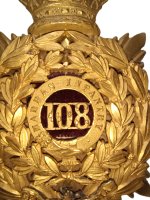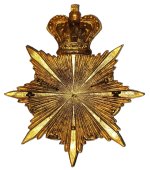Yeohelmetguy
Well-known member
Hello All,
It has some time since I have shared a post here on the Forum. I have acquired a number of interesting and important pieces that I will be sharing going forward. The most recent acquisition to my collection is a very fine, very original, and extremely rare officers home service helmet plate worn by the officers of the 108th Regiment of Foot (Madras Infantry) from 1878 through to 1 July 1881. The helmet plate is a fire gilt eight-pointed star the top upper most ray of the star surmounted by a Victorian crown. Mounted to the star are two laurel wreaths the surround a circular strap inscribed “MADRAS INFANTRY” and in the center of the strap the floriated numerals 108 set on crimson velvet ground. At the base of the wreaths at the bottom of the plate on a two-part scroll is the battle honor “CENTRAL INDIA”. There are three retaining loops to the back of the plate. Helmet plates of this period to East India Company regiments that were taken over by the Crown are exceedingly rare to come by.

The 108th Regiment of Foot (Madras Infantry) was an infantry regiment of the British Army raised by the Honorable East India Company in 1766 as part of the Madras Army. Under the Childers Reforms it amalgamated with the 27th (Inniskilling Regiment of Foot to form the Royal Inniskilling Fusiliers.

The regiment as first raised by the Honorable East India Company as the 3rd Madras European Regiment when it was formed from the 1st Madras Europeans in 1766. It served in India until it was absorbed by the 1st and 2nd Madras Europeans in 1774. It was briefly re-raised in 1777 but disbanded again in 1796. The regiment was re-raised, yet again, as the 3rd Madras (European) Regiment in 1854 and saw action in India in 1857 during the Indian Mutiny also known as the Sepoy Mutiny or Rebellion in support of the Crown. After the Crown took control of the Presidency Armies in the aftermath of the Indian Mutiny, the regiment became the 3rd Madras Infantry in November 1859. It was then renumbered as the 108th Regiment of Foot (Madras Infantry) on transfer to the British Army in September 1862. It embarked for England in 1876 and was posted in Ireland. As part of the Cardwell Reforms of the 1870s, where single-battalion regiments were linked together to share a single depot and recruiting district in the United Kingdom, the 108th Regiment of Foot (Madras Infantry) was linked with the 27th (Inniskilling) Regiment of Foot and assigned to district number 64 at St Lucia Barracks, Omagh. On 1 July 1881, the Childers Reforms came into effect and the 108th regiment of Foot (Madras Infantry) amalgamated with the 27th (Inniskilling) Regiment of Foot to form the Royal Inniskilling Fusiliers becoming the new regiments second battalion, the 27th Regiment of Foot became the regiments first battalion.
Cheers,
David


It has some time since I have shared a post here on the Forum. I have acquired a number of interesting and important pieces that I will be sharing going forward. The most recent acquisition to my collection is a very fine, very original, and extremely rare officers home service helmet plate worn by the officers of the 108th Regiment of Foot (Madras Infantry) from 1878 through to 1 July 1881. The helmet plate is a fire gilt eight-pointed star the top upper most ray of the star surmounted by a Victorian crown. Mounted to the star are two laurel wreaths the surround a circular strap inscribed “MADRAS INFANTRY” and in the center of the strap the floriated numerals 108 set on crimson velvet ground. At the base of the wreaths at the bottom of the plate on a two-part scroll is the battle honor “CENTRAL INDIA”. There are three retaining loops to the back of the plate. Helmet plates of this period to East India Company regiments that were taken over by the Crown are exceedingly rare to come by.

The 108th Regiment of Foot (Madras Infantry) was an infantry regiment of the British Army raised by the Honorable East India Company in 1766 as part of the Madras Army. Under the Childers Reforms it amalgamated with the 27th (Inniskilling Regiment of Foot to form the Royal Inniskilling Fusiliers.

The regiment as first raised by the Honorable East India Company as the 3rd Madras European Regiment when it was formed from the 1st Madras Europeans in 1766. It served in India until it was absorbed by the 1st and 2nd Madras Europeans in 1774. It was briefly re-raised in 1777 but disbanded again in 1796. The regiment was re-raised, yet again, as the 3rd Madras (European) Regiment in 1854 and saw action in India in 1857 during the Indian Mutiny also known as the Sepoy Mutiny or Rebellion in support of the Crown. After the Crown took control of the Presidency Armies in the aftermath of the Indian Mutiny, the regiment became the 3rd Madras Infantry in November 1859. It was then renumbered as the 108th Regiment of Foot (Madras Infantry) on transfer to the British Army in September 1862. It embarked for England in 1876 and was posted in Ireland. As part of the Cardwell Reforms of the 1870s, where single-battalion regiments were linked together to share a single depot and recruiting district in the United Kingdom, the 108th Regiment of Foot (Madras Infantry) was linked with the 27th (Inniskilling) Regiment of Foot and assigned to district number 64 at St Lucia Barracks, Omagh. On 1 July 1881, the Childers Reforms came into effect and the 108th regiment of Foot (Madras Infantry) amalgamated with the 27th (Inniskilling) Regiment of Foot to form the Royal Inniskilling Fusiliers becoming the new regiments second battalion, the 27th Regiment of Foot became the regiments first battalion.
Cheers,
David


